Part -1 》》INTRODUCTION TO SOURCES OF ENERGY
CHAPTER :-
SOURCES OF ENERGY
PART -2
Conventional sources of energy
Hydel Energy:
• Hydel energy is produced by utilizing the kinetic energy of flowing water.
• Huge dams are built over a source of water
• Water is collected behind the dam and released.
• When the water falls on the turbine; the turbine moves, because of kinetic energy of water.
• Thus, electricity is generated by the turbine. Electricity, thus generated is called hydel energy or hydroelectricity.
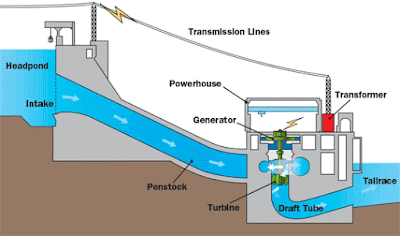 |
| Working of hydroelectricity plant |
• Water in the reservoir is replenished with rainwater and so availability of water is not a problem for hydroelectricity.
Advantages of Hydroelectricity:-
1. It does not cause any environmental pollution.
2. The moving water needed for the purpose is available free of cost.
3. Water is a renewable sources of energy. Each time when it rains l, reservoir of dam gets filled.
4. The construction of dams on river, helps in controlling flood.
Disadvantage of Hydroelectricity:-
1. Construction of dams may lead to economical damage.
2. A large variety of plants , animals and their habitates get submerged in water.
3. It decreases the fertility of the soil in the downstream area and affects crops.
4. The vegetation that gets submerged under water at the dam site (mean decompose) under anaerobic conditions and gives rise to methane , which is a green house gas.
Thermal Power Plant:
• In a thermal power plant, coal or petroleum is used for converting water into steam.
• The steam is used to run the turbine to generate electricity.
All components or parts of thermal power plant is shown in figure below-
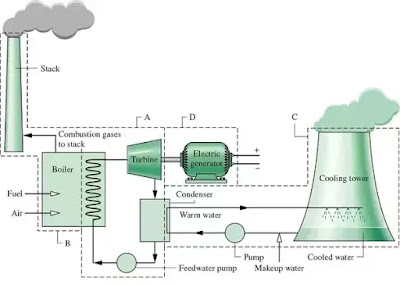 |
| Construction of thermal power plant |
• In thermal power plant boiler is the place where fuel is burnt in presence of air and heat is produced.
• This heat is used to heat up water to convert it into stream.
• This steam is pressurized to turbine and turbine start rotating. This turbine gives mechanical energy to the generator.
• The generator converts mechanical energy into electrical energy.
• This electrical energy is used by us.
Working of thermal power plant can be understand easily by image given below.-
Working of Thermal power plant
Bio-mass:
• The waste material of living things such as cattle dung and dead parts of plant and animals which are used as source of energy is called bio-mass.
• The energy obtained from the bio mass is called bio-energy.
• Bio-energy can be utilised to generate electricity.
• E.g. :- wood , crop residues, bagasse( residues of sugarcane after extraction juice) and animal dung etc.
Bio-Gas :-
• Bio-gas is a mixture of methane, hydrogen sulphide, and carbon di oxide and hydrogen.
• It is produced by the decomposition of bio-mass.
Bio-gas Plant:
• Bio-gas plant can be very useful in solving the energy need of rural areas.
• A bio-gas plant is a dome-like structure which is usually built from bricks and concrete.
• In the mixing tank, the slurry is made from cow-dung and water.
• The slurry then goes to the digester, which is a closed chamber.
• Since oxygen is absent in the digester, the anaerobes carry on their work of decomposition.
• The process of decomposition produces biogas.
• Biogas has about 70% of methane and the rest is composed of other gases.
• The biogas is channelized through a pipe and can be utilized as kitchen fuel and also as fuel for getting light.
• The slurry, left behind is removed. It is used as manure, once it dries.
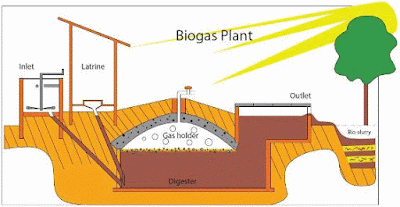 |
| Construction of bio-gas plant |
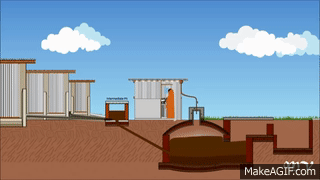 |
| Working of bio-gas plant |
• It burns without smoke, therefore it causes less pollution.
• Its calorofic value is high.
• It is convenient to use and clean fuel.
• The slurry left behind in the digester is a good manure rich in nitrogen and phosphorus. It can be used at fertilizer.
CONTINUE READING
SOURCES OF ENERGY
PART - 3 》》 NON-CONVENTIONAL SOURCES OF ENERGY
Part -2 | Conventional sources of energy | sources of energy | English
 Reviewed by Er. Ashish kumar wadia
on
September 26, 2019
Rating:
Reviewed by Er. Ashish kumar wadia
on
September 26, 2019
Rating:
 Reviewed by Er. Ashish kumar wadia
on
September 26, 2019
Rating:
Reviewed by Er. Ashish kumar wadia
on
September 26, 2019
Rating:
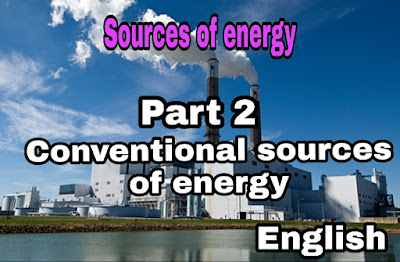
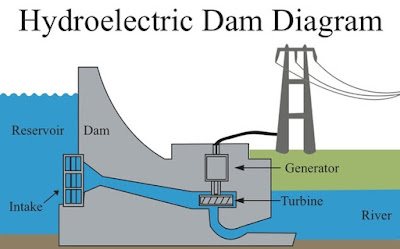
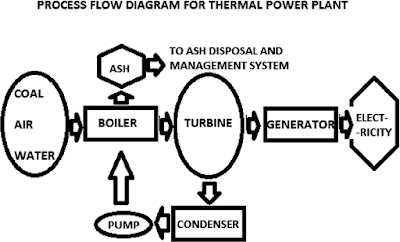





No comments: